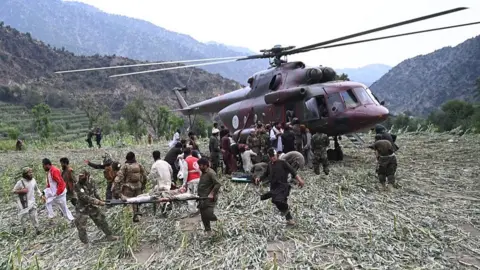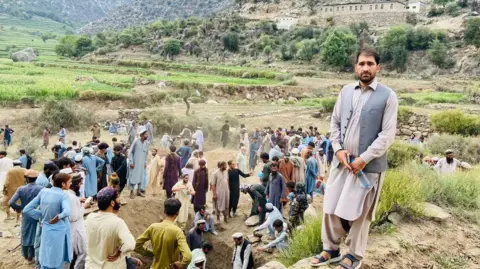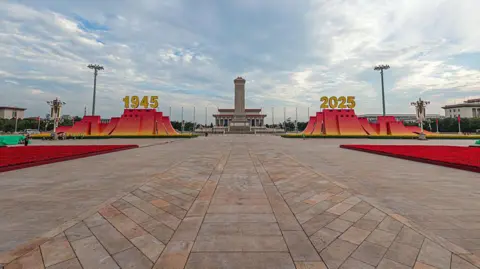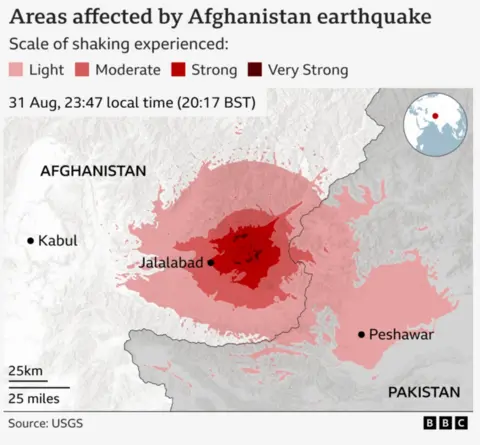The Pacific region experienced significant tension and turmoil following a powerful 8.8 magnitude earthquake that struck the Kamchatka Peninsula in Russia at 11:25 local time (00:25 BST) on Wednesday. This seismic event resulted in immediate tsunami warnings, prompting the evacuation of over two million individuals across multiple nations, including parts of Russia, Japan, and Hawaii.
Despite the earthquake’s extraordinary strength, reports indicated no substantial damage or injuries. A tourist in Hawaii reflected on the situation, stating, "The disaster we were expecting did not come." Residents of coastal areas hastily moved to higher ground as waves measuring up to 1.2 meters hit Oahu and 1.7 meters struck Maui. Hawaii's Governor Josh Green issued stern warnings about the risks, stating, "It is not a regular wave. It will actually kill you if you get hit by a tsunami." However, as the day progressed, the Pacific Tsunami Warning Center downgraded the alarm level for Hawaii, acknowledging that a major tsunami was no longer anticipated.
Authorities confirmed that the evacuation orders could be lifted in Hawaii, but officials advised citizens to remain vigilant and cautious of potential flooding. Noteworthy waves, measuring up to 1.09 meters, were reported in Crescent City, California, while San Francisco experienced tidal surges of approximately 0.7 meters. Coastal residents of British Columbia, Canada, were initially placed on alert, but this advisory was later rescinded without incident.
While some coastal areas in Russia suffered tsunami waves reaching 5 meters, resulting in the evacuation of towns like Severo-Kurilsk, initial assessments indicated no serious injuries. The region's officials later lifted the tsunami warning; however, they reported the Klyuchevskoy Volcano had started showing signs of eruption following the tremors.
Japanese authorities were also on high alert, as thousands were roused by tsunami sirens in coastal regions. Over one million individuals were ordered to evacuate in Iwate prefecture. Yet, Prime Minister Shigeru Ishiba noted no confirmed reports of damage so far, a welcome relief after the catastrophic events of the 2011 disaster linked to a prior earthquake and subsequent tsunami. Staff at Fukushima Nuclear Plant were evacuated as a precautionary measure, but the plant reported no abnormalities.
Globally, various Pacific nations, including French Polynesia, Papua New Guinea, and Vanuatu, issued tsunami alerts, advising people to seek higher ground. While several alerts were eventually canceled, alerts lingered over parts of Chile, Mexico, and New Zealand due to the potential threat of smaller wave activity.
The earthquake occurred within the "Pacific Ring of Fire," a seismically active zone renowned for frequent seismic activity and earthquakes, representing about 80% of Earth's seismic occurrences. This quake is categorized as one of the joint largest recorded earthquakes in history, echoing previous seismic events off the coasts of other countries in the region and serving as a reminder of nature's potent force.
As communities in affected areas reassess and recover, the focus pivots to preparedness for any future seismic activities that may arise from this dynamic and unpredictable geological landscape.
Despite the earthquake’s extraordinary strength, reports indicated no substantial damage or injuries. A tourist in Hawaii reflected on the situation, stating, "The disaster we were expecting did not come." Residents of coastal areas hastily moved to higher ground as waves measuring up to 1.2 meters hit Oahu and 1.7 meters struck Maui. Hawaii's Governor Josh Green issued stern warnings about the risks, stating, "It is not a regular wave. It will actually kill you if you get hit by a tsunami." However, as the day progressed, the Pacific Tsunami Warning Center downgraded the alarm level for Hawaii, acknowledging that a major tsunami was no longer anticipated.
Authorities confirmed that the evacuation orders could be lifted in Hawaii, but officials advised citizens to remain vigilant and cautious of potential flooding. Noteworthy waves, measuring up to 1.09 meters, were reported in Crescent City, California, while San Francisco experienced tidal surges of approximately 0.7 meters. Coastal residents of British Columbia, Canada, were initially placed on alert, but this advisory was later rescinded without incident.
While some coastal areas in Russia suffered tsunami waves reaching 5 meters, resulting in the evacuation of towns like Severo-Kurilsk, initial assessments indicated no serious injuries. The region's officials later lifted the tsunami warning; however, they reported the Klyuchevskoy Volcano had started showing signs of eruption following the tremors.
Japanese authorities were also on high alert, as thousands were roused by tsunami sirens in coastal regions. Over one million individuals were ordered to evacuate in Iwate prefecture. Yet, Prime Minister Shigeru Ishiba noted no confirmed reports of damage so far, a welcome relief after the catastrophic events of the 2011 disaster linked to a prior earthquake and subsequent tsunami. Staff at Fukushima Nuclear Plant were evacuated as a precautionary measure, but the plant reported no abnormalities.
Globally, various Pacific nations, including French Polynesia, Papua New Guinea, and Vanuatu, issued tsunami alerts, advising people to seek higher ground. While several alerts were eventually canceled, alerts lingered over parts of Chile, Mexico, and New Zealand due to the potential threat of smaller wave activity.
The earthquake occurred within the "Pacific Ring of Fire," a seismically active zone renowned for frequent seismic activity and earthquakes, representing about 80% of Earth's seismic occurrences. This quake is categorized as one of the joint largest recorded earthquakes in history, echoing previous seismic events off the coasts of other countries in the region and serving as a reminder of nature's potent force.
As communities in affected areas reassess and recover, the focus pivots to preparedness for any future seismic activities that may arise from this dynamic and unpredictable geological landscape.




















